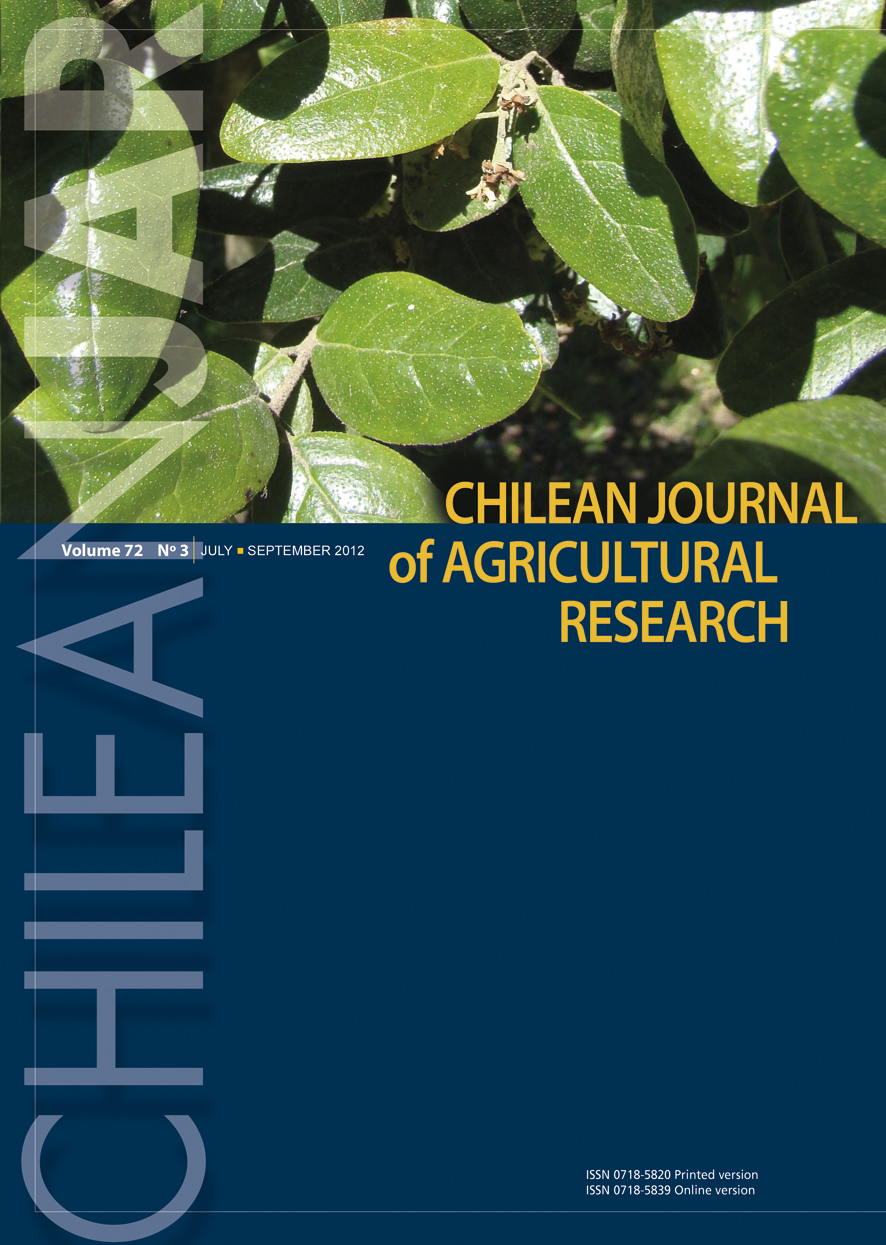
|
Chilean Journal of Agricultural Research
Instituto de Investigaciones Agropecuarias, INIA
ISSN: 0718-5820
EISSN: 0718-5820
Vol. 70, No. 2, 2010, pp. 191-198
|
 Bioline Code: cj10020
Bioline Code: cj10020
Full paper language: English
Document type: Research Article
Document available free of charge
|
|
|
Chilean Journal of Agricultural Research, Vol. 70, No. 2, 2010, pp. 191-198
| en |
Leaf surface scanning electron microscopy of 16 mulberry genotypes ( Morus  spp.) with respect to their feeding value in silkworm ( Bombyx mori spp.) with respect to their feeding value in silkworm ( Bombyx mori  L.) rearing L.) rearing
Singhal, B. K.; Baqual, M. F.; Khan, M. A.; Bindroo, B. B. & Dhar, A.
Abstract
Mulberry ( Morus

spp.) is the only silkworm
( Bombyx mori

L.) food plant. In Indian sub tropics,
S-146 is the only popular and ruling mulberry genotype for silkworm rearing. As a result, mulberry leaf availability is always the limiting factor,
and therefore, sub tropics are contributing less than 1 % of the country′s total silk production compared with more than 60% under
tropical conditions. Besides climatic conditions, this is due to a very limited number of mulberry genotypes available in this region for silkworm rearing.
However, in the mean time, 15 mulberry genotypes viz. `Tr-10′, `Chinese White′, `K-2′, `SujanpurLocal′, `BC 2 59′,
`S-1635′, `C-1730′, ′Mandalaya′, `S-30′ (Vishala), `RFS-175′, ′Anantha′, `C-2016′, `C-2017′, `S-41′
and `V 1′ were also introduced in the sub tropics, but remained unexplored. In sericulture, leaf surface is also an important parameter for, both, the silkworm′s
acceptability of not having any feeding impediment and the mulberry improvement programs. The objective of this study was to explore the possibilities of using these 16 mulberry
genotypes for their leaf surface characteristics by scanning electron microscopy and using them for sericulture. Based on leaf yield, stomatal size, stomatal number per unit of
area and trichomes and idioblasts length, these genotypes were grouped into different categories. The mulberry genotype ′Mandalaya′, in addition to the ruling
genotype `S-146′ excelled because of their higher leaf yield and desired leaf surface characteristics. Furthermore, the genotypes `K-2′, `S-41′
and ′Sujanpur Local′ are also suggested to develop high yield mulberry genotypes in the Indian sub tropics.
Morus indica, scanning electron microscopy, stomata, trichomes, idioblasts, leaf yield, sericulture
|
| |
| es |
Microscopía electrónica de barrido de la superficie foliar de 16 genotipos de Morus  spp. en relación a su valor alimenticio para crianza del gusano de la seda ( Bombyx mori spp. en relación a su valor alimenticio para crianza del gusano de la seda ( Bombyx mori  L.). L.).
Singhal, B. K.; Baqual, M. F.; Khan, M. A.; Bindroo, B. B. & Dhar, A.
Resumen
La morera ( Morus

spp.) es la única
planta de alimento para el gusano de la seda ( Bombyx mori

L.). En los sub-trópicos de la India, ‘S-146’ es el
único genotipo popular y predominante de morera para
criarlo. Como resultado, la disponibilidad de hojas
es siempre el factor limitante y, por lo tanto, los sub-
trópicos contribuyen con menos de 1% del total de la
producción nacional de seda comparado con más de 60%
bajo condiciones tropicales. Además de las condiciones
climáticas, esto se debe al número muy limitado de
genotipos de morera disponible en esta región para la
crianza de gusanos de seda. Se introdujeron 15 genotipos
de morera (Tr-10’, ‘Chinese White’, ‘K-2’, ‘Sujanpur
Local’, ‘BC2-59’, ‘S-1635’, ‘C-1730’, ‘Mandalaya’, ‘S-
30’ (Vishala), ‘RFS-175’, ‘Anantha’, ‘C-2016’, ‘C-2017’,
‘S-41’ and ‘V-1’) a los sub-trópicos, pero permanecieron
inexplorados. En sericultura, la superficie foliar es también
un parámetro importante para la aceptación por parte del
gusano por no tener inconvenientes alimentarios y para
los programas de mejoramiento de morera. El objetivo del
estudio fue explorar las posibilidades de utilizar estos 16 genotipos para sericultura evaluando las características de
su superficie foliar por microscopía electrónica de barrido.
Los genotipos se agruparon en diferentes categorías
según producción foliar, tamaño y número de estomas
por unidad de área, y longitud de tricomas e idioblastos.
Destacó ‘Mandalaya’ junto al popular ‘S-146’ por su
producción foliar y características deseadas de superficie
foliar. Además, basado en las características de sus hojas,
los genotipos ‘K-2’, ‘S-41’ y ‘Sujanpur Local’ también
se sugieren para desarrollar genotipos de morera de alto
rendimiento en los sub-trópicos de la India.
Morus indica L., microscopía electrónica de barrido, estomas, tricomas, idioblastos, producción foliar, sericultura.
|
| |
© Copyright 2010 Chilean Journal of Agricultural Research.
Alternative site location: http://www.inia.cl
|
|
